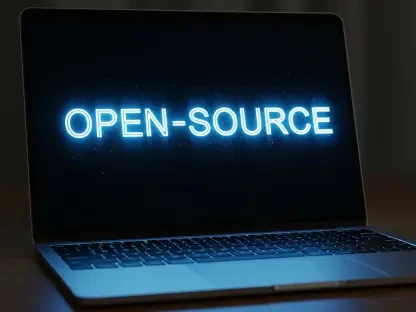Artificial Intelligence (AI) is orchestrating a transformative shift in the realm of software development, enhancing the capabilities of developers through AI-assisted programming. Leveraging advanced algorithms and machine learning techniques, AI is making significant strides across the Software Development Life-Cycle (SDLC). This shift is evidenced by the emergence of AI-assisted coding tools such as Cursor, GitHub Copilot, and Tabnine. These tools exemplify how AI can redefine developer roles by augmenting efficiency and accuracy, moving the traditional coder closer to the role of an orchestrator within an AI-driven development ecosystem. Although the benefits are extensive, organizations must also recognize the limitations and potential risks associated with integrating these powerful tools into their workflows. The future of programming is thus positioned at the intersection of human ingenuity and AI collaboration.
AI’s Role in Enhancing Coding Efficiency
AI is revolutionizing the developer experience by making the coding process more intuitive and efficient. AI automates routine tasks such as code documentation, allowing developers to focus on more complex and creative work. This increased efficiency is one of the most significant benefits of AI in software development. AI can detect bugs and vulnerabilities more effectively, enhancing the overall quality of the code. This improved accuracy ensures that the final product is more reliable and secure.
AI tools expedite various aspects of development, such as code generation and completion, resulting in quicker software project delivery. This enhanced productivity allows developers to meet tight deadlines and deliver high-quality software faster. Additionally, AI facilitates the creation of more personalized and user-centric software applications, catering to the specific needs and preferences of users.
Existing academic research indicates that AI can reduce the time developers spend on generic programming tasks by up to 50%. The degree of productivity boost provided by AI tools, however, varies based on the type of task, the role of the developer, and the primary programming language used. AI assistants are particularly adept at automating straightforward tasks, such as code documentation, but their impact diminishes with tasks that require human judgment, such as bug detection and fixing. This underscores AI’s role more as a catalyst for generating and iterating code swiftly rather than a substitute for the entire development process.
The best AI coding tools aim not to replace developers, but to enhance the collaboration between humans and AI. This partnership optimizes the coding process and allows developers to focus more on stimulating and creative aspects of their work. Tools like Cursor, for instance, act as virtual colleagues, predicting and anticipating code changes to give developers greater control over their code base. This approach enables developers to dedicate more time to solving complex problems, designing innovative solutions, and delivering greater value through the products they build. Consequently, AI tools can lead to increased job satisfaction and a more fulfilling development process.
Examples in the Market
The market for AI coding assistants is rapidly expanding, attracting significant investments. For example, the Paris-based startup Poolside secured $500 million in funding prior to the launch of their product. Similarly, Magic announced a $320 million funding round with participation from high-profile investors like Eric Schmidt, Sequoia, and CapitalG. This funding has granted Magic access to Google Cloud’s AI supercomputers, underscoring the increasing market interest in AI-driven coding.
Companies like Amazon are also investing heavily in Generative AI for coding. Andy Jassy, Amazon’s CEO, reported that their GenAI assistant, Amazon Q Developer, has dramatically streamlined software upgrades in enterprise environments. He estimates that this efficiency has saved Amazon approximately 4,500 developer-years of work and yielded $260 million in annual efficiency gains, allowing teams to focus on more strategic initiatives.
Tabnine, an early pioneer in AI-driven coding, serves over a million users and continues to innovate. Recently, it announced major upgrades to its coding assistant, incorporating Retrieval-Augmented Generation (RAG) techniques to provide more personalized and context-aware code suggestions. Devin, developed by Cognition Labs, is branded as an ‘AI software developer’ with full-stack capabilities, designed to collaborate with users on complex engineering tasks.
As AI-driven coding technologies evolve, both established tech companies and startups stand to benefit from the burgeoning opportunities. Regardless of the preferred tools and technologies, the consensus in the industry is clear: Generative AI is poised to fundamentally reshape the approach to coding and software development. The development of AI-generated code platforms shows no sign of slowing down, and with major tech players committed to furthering these innovations, developers can expect even more integration and productivity enhancements in the near future.
Limitations in Utilizing AI for Code Generation
While the advancements in AI-powered coding tools are promising, the field is still nascent and faces several challenges. Code quality and reliability are primary concerns. AI-generated code can introduce errors and bugs, necessitating thorough code reviews by developers. The inconsistency of AI outputs requires critical oversight. Additionally, AI models are highly dependent on the quality of their training data. Outdated or biased data can result in code based on deprecated practices or obsolete libraries. This can limit AI’s effectiveness, especially with niche programming languages, and necessitate strategies such as fine-tuning models with specialized code bases.
Security concerns are another significant challenge. AI-generated code may not always consider the latest security vulnerabilities, potentially introducing exploitable weaknesses if not carefully reviewed. The use of AI-generated code can also inadvertently incorporate existing code portions, raising intellectual property and privacy issues. Organizations must navigate these ethical and legal implications, particularly around ownership and the use of AI-generated code in proprietary software.
The limitations of AI-generated code are more pronounced during integration with existing projects, a common task for enterprise developers. Compatibility issues arise when AI-generated code does not align with the project’s architecture, coding standards, or conventions. Managing dependencies and ensuring seamless integration with the rest of the application can be challenging. Thorough testing is essential to verify the functionality of AI-generated code within existing systems, adding complexity to the integration process.
Despite these challenges, the ongoing development of AI coding tools continues to offer promising potential. Researchers and developers are working to refine the capabilities of AI models, helping to improve code quality and reliability. Efforts to enhance the quality of training data, incorporate updated libraries, and maintain compliance with coding standards are among the steps being taken to address the existing weaknesses of AI-generated code. Ethical and security concerns are being prioritized through the creation of more transparent AI decision-making processes and the development of robust guidelines. As these tools evolve, and as developers adapt to the nuances of AI-assisted programming, the early challenges will likely give way to more reliable and effective implementations.
How Organizations Can Introduce AI in Software Development
Introducing AI into an organization’s software development process requires a strategic approach, addressing the limitations discussed and embedding robust processes to evaluate and mitigate risks. To effectively implement an AI coding platform, enterprises should prioritize key functional and non-functional features. Automating and optimizing code generation and refactoring across multiple languages can ensure that developers gain significant productivity benefits. Integrating real-time testing and bug detection can maintain high-quality code, while comprehensive security and vulnerability analysis ensures compliance with best practices and guardrails.
Advanced AI coding platforms should incorporate contextual and domain-specific code suggestions, fine-tuning AI models for project-specific requirements or niche programming languages. Promoting ethical AI usage and transparency in decision-making processes is crucial, alongside implementing measures to reduce bias through high-quality, regularly audited training data. Compatibility with existing systems, frameworks, development tools, DevOps, and CI/CD workflows can streamline integration and enhance overall productivity. AI tools that support version control systems and human-in-the-loop code review processes further ensure reliability.
Providing a user-friendly interface and training resources is essential to enhance the developer experience, ensuring effective use of AI coding features. Furthermore, organizations must maintain human oversight and collaboration, using AI to augment rather than replace their workforce. This balance between automation and human expertise helps teams focus on more strategic and creative tasks, delivering innovative and high-quality software solutions.
Incorporating scalability and performance optimization features ensures that AI tools can handle large workloads without compromising speed. Ensuring customizable code standards tailored to specific organizational needs helps maintain consistency and compliance with internal policies. These features collectively enable organizations to harness the power of AI to enhance their software development processes while managing potential risks.
By prioritizing these aspects and continually refining their AI systems, organizations can effectively integrate AI into their software development workflows. This not only improves efficiency and productivity but also fosters innovation and quality, driving the development of better software solutions that meet user needs and advance business objectives. As AI technology continues to evolve, embracing these tools can position organizations at the forefront of the software development landscape, capitalizing on the opportunities brought forth by this transformative technology.
Conclusion
The market for AI coding assistants is expanding rapidly, bolstered by substantial investments. For instance, the Paris-based startup Poolside raised $500 million before even launching its product. Meanwhile, Magic secured $320 million in funding from notable investors like Eric Schmidt, Sequoia, and CapitalG, giving them access to Google Cloud’s AI supercomputers. This influx of capital highlights the growing interest in AI-driven coding solutions.
Major companies like Amazon are also diving into Generative AI for programming. According to Andy Jassy, Amazon’s CEO, their AI assistant, Amazon Q Developer, has significantly optimized software updates in enterprise settings. This optimization has reportedly saved Amazon about 4,500 developer-years of effort and resulted in $260 million in annual efficiency gains, allowing teams to concentrate on more strategic tasks.
Tabnine, an early player in AI-driven coding, serves over a million users and continues to innovate. They recently announced significant upgrades to their coding assistant, incorporating Retrieval-Augmented Generation (RAG) techniques, which offer more personalized and context-aware code suggestions. On another front, Cognition Labs has developed Devin, an AI software developer with full-stack capabilities designed to collaborate on complex engineering tasks.
Both established tech companies and startups are poised to benefit as AI-driven coding technologies evolve. The consensus in the industry is clear: Generative AI will fundamentally change how developers approach coding and software development. With continuous innovation and commitment from major tech players, developers can expect further integration and productivity enhancements in the near future.









